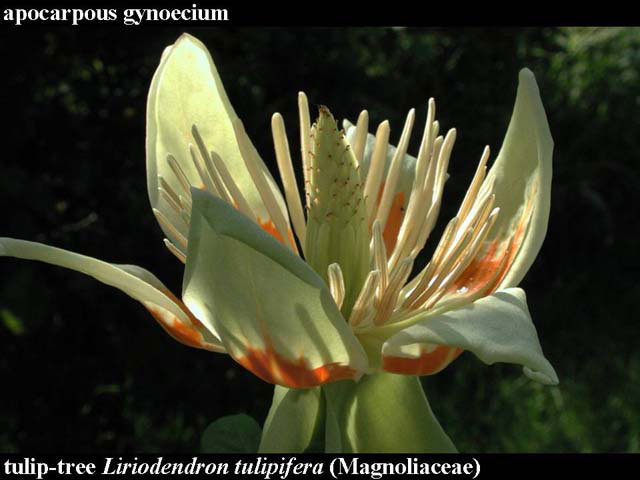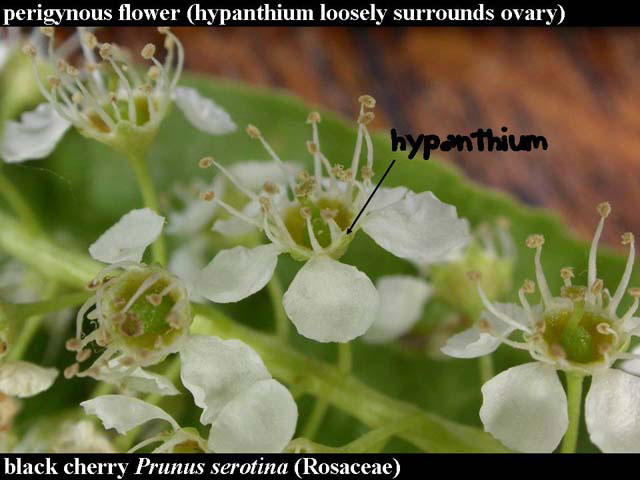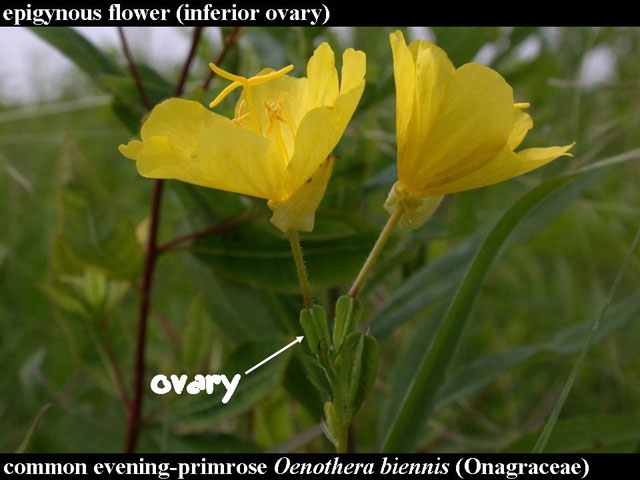Flowering
plants (angiosperms,
meaning "covered seeds") are the superstars of the plant kingdom.
Having evolved fairly recently (late in the Mesozoic Era --the
"age of
dinosaurs"), these innovative newcomers are defined by the presence of
a terrific adaptation enhancing the protection
and dispersal of
seeds, an enclosure called the ovary.
Inasmuch as
the ovary, when ripened, becomes a fruit,
angiosperms may just as well be called "fruiting plants."
Since
it is the female portion
of the flower, the pistil is also referred to as the gynoecium
("female house"). There are three varities of gynoecium: unicarpellate
(sometimes called a "simple pistil), syncarpous
("compound
pistil"), and apocarpous
("multiple pistil").
Plant
anatomy is blessedly
simple. Essentially, a plant has just three organ systems
--roots, shoots, and leaves. Everything else is just one of
those, modified. Thus the flower
can
be regarded as a compressed stem upon which the sepals,
petals,
stamens and pistil are modified leaves. The
basic unit of the pistil is the carpel
--a
modified leaf that produces seeds along its margin.
Imagine an ancestral pre-angiosperm plant with flat
parallel-sided leaves bearing single-file rows of seeds along their
edges. Now
visualize the sides such a leaf folded upwards to meet each
other, with the seedy margins fused to form a single upper margin. Thus
is created a chamber with the seeds trapped inside.
The midvein
becomes the
bottom edge of the chamber. This represents the simplest type
of gynoecium, one formed
from a single carpel, accordingly termed a unicarpellate
gynoecium.
Below,
redbud. This understory tree bears masses of pink-purple
pea-like blossoms in mid-April. Also pea-like in structure (but
inedible), a redbud fruit is a unicarpellate type called
a
"legume."
MOUSEOVER
the image
to see redbud in flower.
Redbud
fruits. Note
the single marginal row of seeds.
Think
of a unicarpellate gynoecium as being like a one-room
shack. Then the more intricate (and more common) syncarpous
gynoecium
is like a house with several rooms. Depending upon the species (usually
it
is a family-level characteristic) syncarpous gynoecia most
often consist of two, three or five carpels fused into a
single
unit. When in flower, clues that a gynoecium is syncarpous (and how
many carpels it comprises) can be gleaned from counting a
flower's stigmas or stigma-lobes, or looking for
ridges on the ovary that correspond to the edges of fused
carpels.
A cross section of the ovary, in flower or in fruit, will often reveal
some definite number of partial or complete individual
chambers, or
at least
separate rows of seeds, indicating carpel number.
Below,
wild hyacinth. This spring wildflower is abundant in rich woods
and also prairie remnants in central Ohio.
MOUSEOVER
the image
to see an ovary cross-section.
If
the unicarpellate gynoecium
is a
one-room shack, and the syncarpous gynoecium a several-room house,
then the apocarpous gynoecium is
a small tract of land with several one-room shacks on it. Several
separate stigma/style/ovary units are perched together on a single
flower. (This makes it possible for one flower to give rise
to more than one
fruit).
Below,
tulip tree. This is a magnificent forest giant, producing easily
worked, knot-free lumber that is marketed as "yellow-poplar." (That is
a
misleading name, since it is not
closely related to
poplars, aspens, and cottonwood). It's not related to tulips either.
It's more like a magnolia.
MOUSEOVER
the image
to see tulip-tree fruiting.

Tulip-tree flower.
B.
Relative Insertion of Floral Parts
(flower
type and ovary position)
Flower parts
are produced from bottom to top in the order: calyx, corolla,
androecium, gynoecium (pistil). In many instances
they
clearly appear to be in that orderly arrangement as well. There is
variation, however, in the manner in which the parts actually rise off
of the flower, resulting in three categories of "flower type
and
ovary position" describing how the parts are positioned with respect to
the all-important ovary. There are three such categories: (1)
hygogynous with a superior ovary, (2) perigynous with a superior ovary
and (3) epigynous with an inferior ovary.
Below, bloodroot. This
early-spring wildlflower neatly
demonstrates a HYPOGYNOUS flower with a SUPERIOR OVARY. The sepals
(which have fallen off), the petals, and the stamens are separate from
one another and they are inserted, and rise off of the flower,
beneath ("hypo") the pistil (gynoecium). The ovary position is termed
"superior" because it is located above the other flower parts.
The
bloodroot flower is hypogynous with a superior ovary.
Some
flowers, particularly those of the
rose family (Rosaceae) are PERIGYNOUS, also (like hypogynous) with a
SUPERIOR OVARY. Here (and in the epigynous flowers described below),
there is a special stucture,
a hypanthium,
also called the "floral cup," that consists of the
lower portions of the sepals, petals, and stamens fused together for a
short distance. The individiual sepals, petals, and stamens rise off of
the flower along the rim of the hypanthium, around ("peri") the pistil
(gynoecium). Imagine a ping-pong ball in a teacup. The ball is the
ovary; the cup is the hypanthium. Because the actual attachment point
is still below the ovary, the ovary position here is superior just as
it is in hypogynous flowers.
Below, black cherry. This is a native hardwood tree that produces a
prized cabinet wood. Shade-intolerant, it grows in old fields and is
one of the earliest trees in secondary succession to a forest.

Black cherry flowers are perigynous withy a superior ovary.
If a perigynous flower is like a ping-pong ball ovary in a teacup
hypanthium, then the epigynous flower is like instead a glue-covered
tennis ball jammed forciibly into the teacup. A hypanthium (floral cup)
is present, but it is tightly fused to the ovary. Hence, the other
flower parts are attached above ("epi") to the gynoecium. The overy
position is termed "inferior" because it is situated beneath everything
else.
Below, common evening-primrose. This weed flowers at night, is
pollinated by moths.

Evening-primose flowers are epigynous with an inferior ovary.
Back:
Flowers&Fruits Menu


Next:
1-seeded Dry Fruits

